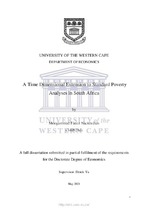| dc.description.abstract | Most poverty studies ignore the dimension of time and are merely concerned if an individual meets certain money-metric or non-income welfare (e.g., access to services and asset ownership) criteria. They fail to recognise the limited time (24hours per day) available to complete tasks and the added difficulties they have even though there is an abundance of money-metric and asset-related non-money-metric poverty studies. (Kim et al. 2014:1). For example, individuals/households deemed poor by standard measures cannot afford market alternatives to assist them with non-market work (like childcare). Therefore, they find themselves spending all their time in market and non-market work without taking time for rest and improving themselves. Recognising non-market work and the allocation of time allows for a greater understanding into the role of women and Africans whose non-market work are unrecognised by standard economic measures such as GDP (Ferrant 2014:1). There are also only a few in-depth studies on time poverty, but they fail to utilise the most current data. Therefore, this study seeks to provide insights into how household production impacts on South African welfare. It explores the income, time poor and the extent of time allocation differences for various personal characteristics. It estimates the likelihood of time poverty based on an individual’s time schedule and the factors which most likely results in time poverty. In this study, various time concepts and measures were explored adding to the scarcely found South African time poverty studies which lack in-depth exploration. At the same time the study highlighted household production, an aspect closely linked to time poverty which affects certain groups of people more (females and Africans), and its welfare implications completely ignored by standard measures of the economy. The study also aimed to examine the relationship between time and income poverty. The study utilised the 2000 and 2010 South African Time Use Survey data by focusing on two main themes: time use patterns (to better understand household production) and time poverty (to measure it and understands its relationship with income poverty). The descriptive results revealed that both mean SNA (System of National Accounts internationally agreed standard for production)) and non-SNA production time increased over time at the cost of the non-productive time. Also, mean paid and unpaid work increased over time. | en_US |

